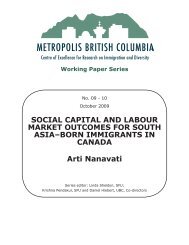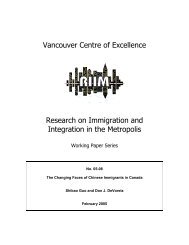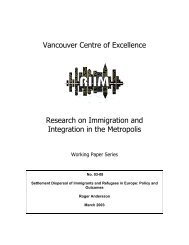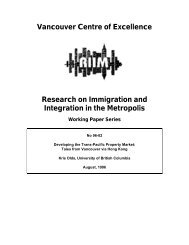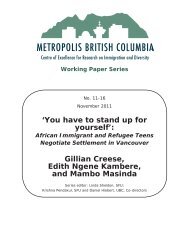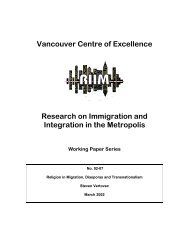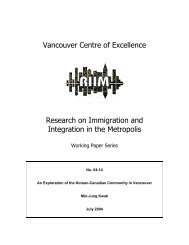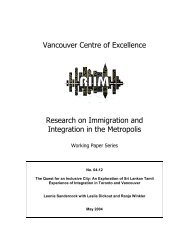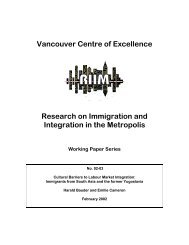Characteristics of Immigrant Transnationalism in ... - Metropolis BC
Characteristics of Immigrant Transnationalism in ... - Metropolis BC
Characteristics of Immigrant Transnationalism in ... - Metropolis BC
Create successful ePaper yourself
Turn your PDF publications into a flip-book with our unique Google optimized e-Paper software.
4<br />
immigration <strong>in</strong> the Vancouver hous<strong>in</strong>g market more generally has been appreciable; between 1986 and<br />
2001 immigration dom<strong>in</strong>ated population growth and a very high correlation existed between annual<br />
immigration land<strong>in</strong>gs and the movement <strong>of</strong> metropolitan house prices (Ley and Tutchener 2001).<br />
The sett<strong>in</strong>g <strong>of</strong> a gateway city with a large, newly landed population add<strong>in</strong>g to exist<strong>in</strong>g co-ethnic<br />
communities provides a fertile laboratory for transnational behaviour. Case studies have demonstrated<br />
the existence <strong>of</strong> transnational activities among the largest immigrant communities, from Hong Kong<br />
and Taiwan (Waters 2002; Ley and Waters 2003) and from India, particularly the Punjab (Walton-<br />
Roberts 2003). In this chapter we make use <strong>of</strong> a large metropolitan survey <strong>of</strong> 1479 immigrants<br />
conducted <strong>in</strong> 2001 to assess the <strong>in</strong>tensity <strong>of</strong> transnationalism along a number <strong>of</strong> dimensions and to<br />
establish relationships between transnational practices and socio-economic and ethno-cultural<br />
characteristics <strong>of</strong> the population.<br />
<strong>Transnationalism</strong>: the story so far<br />
Soon after Friedmann’s pioneer<strong>in</strong>g discussion <strong>of</strong> global cities followed the early literature on<br />
transnationalism. Anthropologists noted a high density <strong>of</strong> transactions between immigrants to the<br />
United States and relatively proximate home countries like Haiti and the Dom<strong>in</strong>ican Republic <strong>in</strong> the<br />
Caribbean (Glick Schiller et al. 1992), and Central America, notably Mexico (Rouse 1992). This early<br />
work on nearby send<strong>in</strong>g nations has cont<strong>in</strong>ued (Mountz and Wright 1996; Guarnizo 1998; Glick<br />
Schiller and Fouron 1999; Levitt 2001; Pries 2001), and has also expanded to many other regional<br />
sett<strong>in</strong>gs <strong>in</strong>clud<strong>in</strong>g transnational flows between East Asia and North America (Mitchell 1997; Ong and<br />
Non<strong>in</strong>i 1997; Ong 1999; Ley 2000), among countries <strong>in</strong> Asia (Yeoh, Willis and Fakhri 2003), and<br />
between Africa and Europe (Ali-Ali, Black and Koser 2001), amongst others.<br />
Transnational ties have been obscured <strong>in</strong> the past <strong>in</strong> the Canadian literature on ethnicity that has<br />
been based on assimilation or multicultural frameworks, both <strong>of</strong> which have presupposed a model <strong>of</strong><br />
immigrant conta<strong>in</strong>ment with<strong>in</strong> national borders (W<strong>in</strong>land 1998). Recently, however, considerable work,<br />
particularly <strong>in</strong> the Vancouver region, has exam<strong>in</strong>ed transnational ties notably among members <strong>of</strong> the<br />
Ch<strong>in</strong>ese diaspora who have been the lead<strong>in</strong>g s<strong>in</strong>gle immigrant group over the past twenty years<br />
(Mitchell 1997; Wong 1997, 2002; Ley 2000; Waters 2002, 2003; Ley and Waters 2003). Other<br />
contributions have demonstrated the diverse l<strong>in</strong>kages between Greater Vancouver (<strong>in</strong> particular<br />
suburban Surrey) and the Punjab (Walton-Roberts 2003), and also the transnational fields <strong>of</strong> much<br />
smaller groups such as the Burmese (Hyndman and Walton-Roberts 2000). One <strong>of</strong> the few Canadian<br />
studies with a larger sample considered the overseas l<strong>in</strong>kages <strong>of</strong> more than 400 immigrants to Quebec,<br />
<strong>in</strong>clud<strong>in</strong>g the scale <strong>of</strong> home country travel, remittances and property ownership, ten years after land<strong>in</strong>g



